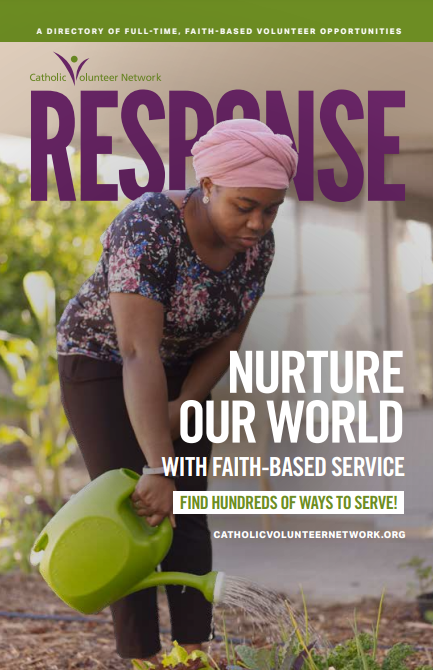By Nikki Rohling, Associate Director
The Statistics
In the most recent Catholic Volunteer Network survey (full results to be published next month at our annual conference), programs reported 61.6 percent of their volunteers were female and 38.4 percent male. This is actually a slight increase in males over the previous year (64.8 percent female and 35.2 percent male in 2009-2010).
Over the last five years, the rates of male volunteers reported by Catholic Volunteer Network has stayed relatively consistent (close to one third).
| 2011 | 2010 | 2009 | 2008 | 2007 | |
| Female | 61.6 | 64.8 | 65.1 | 64.8 | 59.3 |
| Male | 38.4 | 35.2 | 34.9 | 35.2 | 40.7 |
*Rates are in percentages and represent the total number of volunteers (both domestic and international)
We see many of the same trends on college campuses and even before college. Tom King, Assistant Director of Campus Service at Loyola Marymount’s Center for Service and Action, reports that 37 percent of students involved in service organizations on campus are men. So, LMU’s numbers closely align with the national trends as well as Catholic Volunteer Network’s.
In addition, the most recent data from the Higher Education Research Institute at the University of California Los Angeles shows that 21 percent of men entering college had spent at least three hours a week volunteering during their senior year of high school compared with 31 percent of women. Furthermore, only 27 percent of men reported participating in student clubs and groups compared with 38 percent of women.
Obstacles
In talking with professionals working on college campuses as well as some Catholic Volunteer Network colleagues, it is apparent that there are a few common perceived obstacles. First, many young men feel pressure to get a job in their specific career field right out of college. Society, their parents and even their peers expect them to move right into their studied career field after college. Traditionally, the majority of men study math, science or business, but very few volunteer programs offer placement options specifically using these skills (aside from education which not every one wants to pursue). It’s important to not only offer options, but to also help potential volunteers see the potential benefit of their background in math, science or business with particular placement sites.
As a student at John Carroll University, Andy Costigan studied economics and Spanish. When he joined the Jesuit Volunteer Corps in 2008, he hoped he would be able to use his business knowledge and Spanish skills. “I think it’s a wonderful gift to be able to offer diverse skill sets to organizations that volunteer programs work with,” Mr. Costigan said. “I started with Homeboy Industries working on education curricula and then the organization hit hard financial times. I was able to transition into the development office and utilize my business background to help their fundraising efforts.”
Second, is there communication about these opportunities? Word of mouth is one of the most common ways volunteers find out about programs. Do men know these experiences exist? Are volunteer programs doing their part in communicating the requirements, expectations and experience of serving? “Some male students I speak with have a misconception about what’s required to participate,” Mr. King said. “They think that because they did not participate in a service organization on campus that they’re not qualified.”
Finally, are men comfortable enough with their faith and with sharing it in community to take the leap into faith-based post-grad service? Many programs emphasize reflection and sharing as key components. Is this model a more feminine model? “Masculine spirituality emphasizes that doing, or acting, is the primary way of developing a spirituality – not hearing, not talking, not reflecting,” said Fr. Richard Rohr, OFM, Founding Director of the Center for Action and Contemplation. “To be sure, reflection is part of a masculine spirituality, but it come later, after the action.”
Catholic Volunteer Network programs do offer both sides of service – the action as well as the reflection. However, it may serve many programs well to take a critical eye to their materials and the language they use within the organization.
Solutions
It’s easy to say that Catholic Volunteer Network’s statistics are just mirroring the national trends, but how do we break out of that? Here are a few hopefully innovative ideas on how to motivate men to volunteer;
- Find some kind of “pied piper” or peer leader who can help promote the opportunities as a group event. In general, men have a pack mentality and can influence one another. Encourage the pied piper to give encouragement and to hold his peers accountable.
- Think about the language and the structure of the program. Are the materials inviting to male applicants? Host a focus group of former male volunteers and see what they have to say.
- Get creative with marketing. Mike Hebbeler, Director of Student Leadership and Senior Transitions at the University of Notre Dame, said that they use distinct marketing for service programs geared towards male and female students. The posters in the men’s dorms look differently than those in the women’s dorms.
- Recruit outside of the box. If the first point of contact is reporting similar numbers in terms of participation, then go elsewhere. Recruit within greek life, sports teams, math/science classes or basically anywhere there might be more men (the men’s restroom?). “When visiting campus, don’t forget to reach out to areas outside of the recruitment events,” Mr. Hebbeler said.
- As a way of encouraging males into service, host an all-male immersion trip. This might be a place to allow men to grow in community as well as give them a space to share in an intentional way.
- If you have a mixed gender community, consider gender specific meeting times. Colorado Vincentian Volunteers has found this to be a helpful model that allows separate time and space for both gender groups.
Sources
(Jan 2011) The American Freshman: National Norms for Fall 2010. Higher Education Research Institute at the University of California Los Angeles
Peace Corps. “Peace Corps Director Aaron S. Williams’ Response to ABC World News on Jan. 27, 2011.” January 27, 2011. http://www.peacecorps.gov/index.cfm?shell=resources.media.press.view&news_id=1700&cid=rssnews Accessed October 24, 2011.


 Thousands of faith-based service opportunities can be at your fingertips with the RESPONSE. Download the latest edition today!
Thousands of faith-based service opportunities can be at your fingertips with the RESPONSE. Download the latest edition today!
